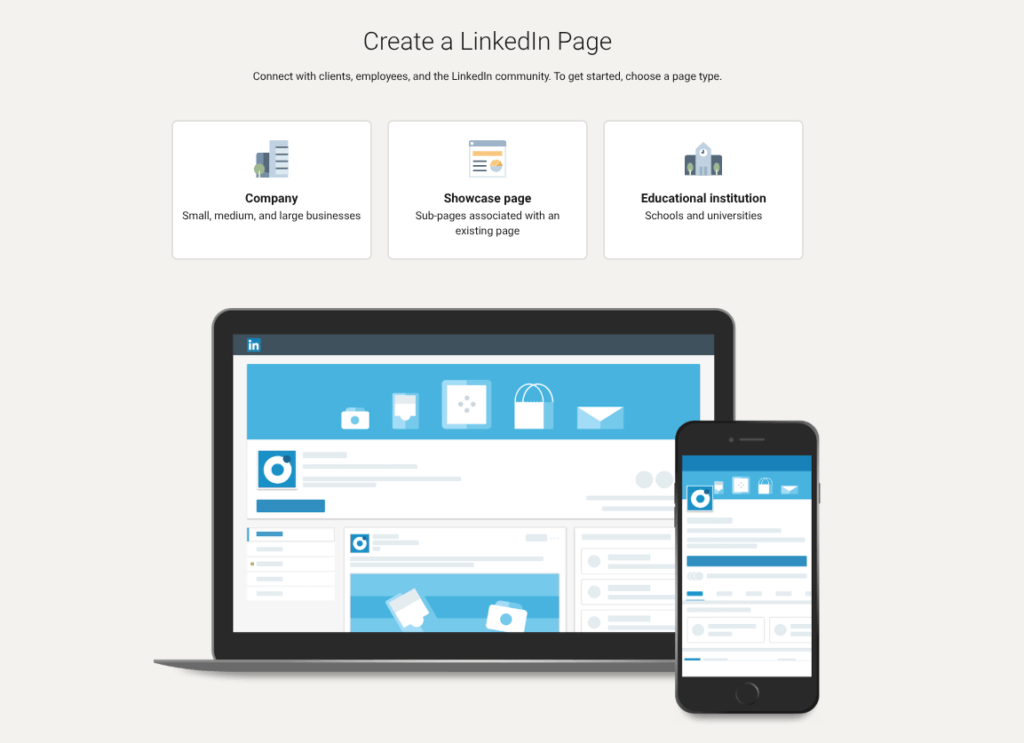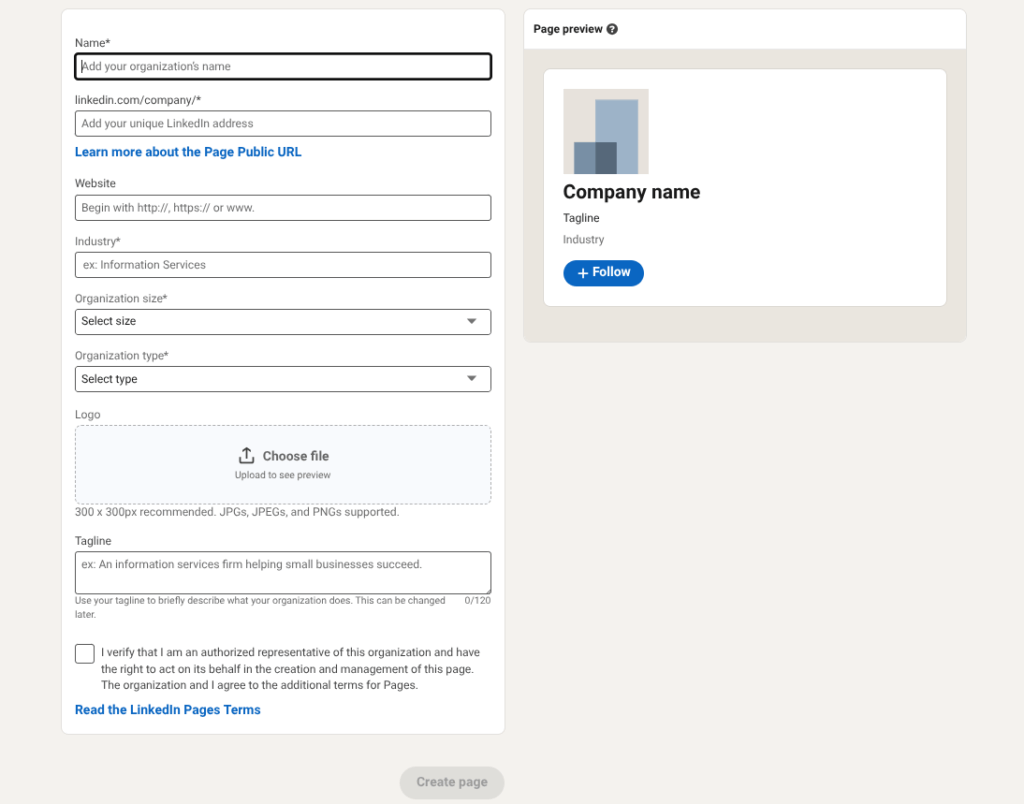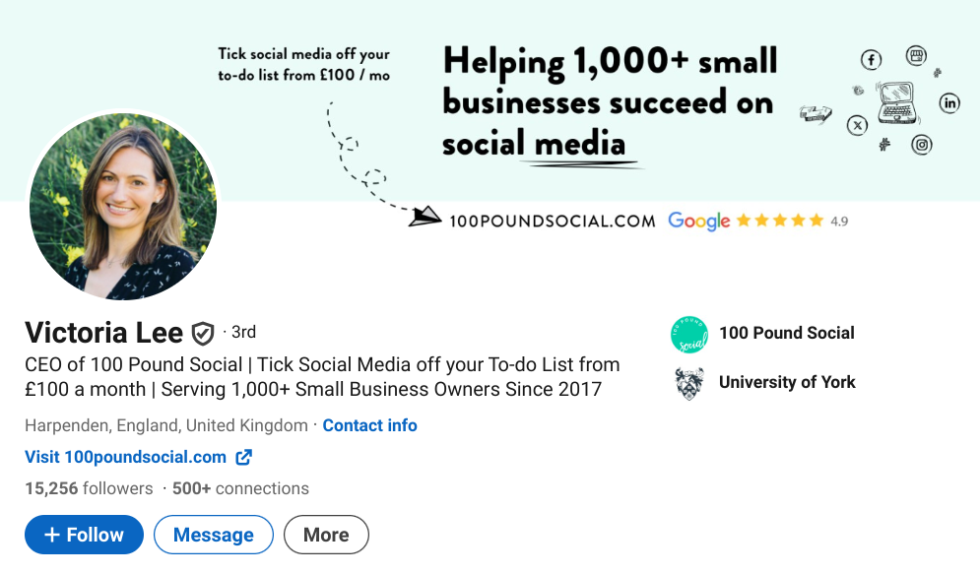Setting up a LinkedIn business page might feel overwhelming when you’re running a small B2B company without a dedicated marketing team.
Between managing clients, handling operations, and keeping the lights on, social media often takes a backseat. But here’s the thing: you don’t need a marketing degree or hours of free time to create a LinkedIn business page that actually works.
LinkedIn stands apart from other social platforms because it connects you directly with the people who matter most to your business—decision-makers, industry peers, and potential clients.
While Facebook and Instagram focus on personal connections, LinkedIn is built specifically for professional relationships and B2B interactions. With over 900 million professionals worldwide and 180 million senior-level influencers, LinkedIn provides unparalleled access to your target market.
Why Every Small B2B Business Needs a LinkedIn Company Page
Think of your LinkedIn Company Page as your business’s professional calling card that works around the clock. When prospects research your company (and 76% of B2B buyers do this before making contact), a polished LinkedIn presence immediately signals credibility and professionalism.
It’s often the difference between being seen as an established business versus a fly-by-night operation.
Many small business owners underestimate LinkedIn’s power, viewing it as just another social media platform to manage. This perception costs them significant opportunities. Unlike consumer-focused platforms, LinkedIn users are in a professional mindset when they browse, making them more receptive to business-related content and connections.
Step 1: Set Up Your Page
Go to LinkedIn’s “Create a Company Page” Tool
Navigate to LinkedIn’s Create a Company Page tool using your personal LinkedIn account. You’ll need an established personal profile to create a company page—LinkedIn requires this to prevent spam and ensure accountability. If your personal profile is incomplete, take a few minutes to add a professional photo and basic information before proceeding.
When you reach the company page creation screen, you’ll see several options: Small Business, Medium to Large Business, Showcase Page, and Educational Institution.
For most B2B companies with fewer than 200 employees, select “Small Business.” This option provides all essential features without the overwhelming complexity designed for enterprise-level organisations.


Understanding Page Types and Their Implications
The “Small Business” designation affects how LinkedIn categorises your page and which features become available. Small business pages include follower demographics, basic analytics, and the ability to post updates, but lack some advanced features like dynamic ads or lead generation forms that larger companies might need.
However, these limitations rarely impact small B2B businesses, and you can always upgrade your page type as your company grows.
Add Your Company Name and Custom LinkedIn URL
When entering your company name, use your official business name exactly as it appears on your website, business cards, and legal documents. Consistency across all platforms builds trust and makes it easier for people to find and recognise your business. Avoid using taglines or descriptive phrases in your company name field—save these for your headline and about section.
Here’s where many business owners miss a crucial opportunity: customising your LinkedIn URL.
By default, LinkedIn assigns URLs with random numbers (like linkedin.com/company/123456). Instead, create a custom vanity URL that matches your brand.
To do this, navigate to your company page and look for “Edit public URL” under Admin tools on the right side.
Replace the numeric ID with your desired vanity URL (like “smith-consulting”), checking for availability since LinkedIn URLs are unique.
If your preferred URL is taken, try variations with hyphens, locations, or business abbreviations before saving your changes.
Download Our FREE LinkedIn Post Examples →
Step 2: Add a Professional Logo and Banner
Upload Your Logo—Technical Requirements and Quality Standards

Your logo serves as the cornerstone of your visual brand identity on LinkedIn. Upload a high-quality version optimised for digital display—300 x 300 pixels minimum resolution works best, though LinkedIn accepts up to 300 x 300 pixels maximum. Use PNG format for logos with transparent backgrounds or JPG for simpler designs.
To upload your logo, navigate to your LinkedIn company page and switch to admin view, then click “Edit Page” in the left-hand menu. Select “Page info” from the left menu and click the edit icon on your current logo (or placeholder image). Choose your high-quality image file from your computer and click “Save” to complete the upload process.
If your current logo appears pixelated, blurry, or outdated, consider this an investment opportunity. A professional logo redesign typically costs between £200-£800 but pays dividends in perceived credibility and brand recognition. Many prospects make subconscious judgments about your business quality based solely on visual presentation.
Logo Optimisation Tips:
- Ensure your logo is readable at small sizes (it appears as a small circle in feeds)
- Use high contrast colours that stand out against LinkedIn’s white background
- Test how your logo looks on mobile devices, where most LinkedIn browsing occurs
- Consider creating a simplified version of complex logos for better digital visibility
- Save multiple versions (square, horizontal, vertical) for different platform requirements
Create a Banner Image That Converts
Your banner image occupies prime real estate at the top of your page (1128 x 191 pixels) and offers valuable space to communicate your value proposition instantly. This banner appears before visitors read any text, making it crucial for first impressions. Instead of generic stock photos or abstract designs, use this space strategically to convey what your business does and why it matters.
Effective Banner Elements:
- Your company tagline or value proposition
- Key services or specialisations
- Contact information (phone, website, location)
- Professional photos of your team or workspace
- Client logos or testimonials (with permission)
- Industry certifications or awards
Step 3: Craft a Compelling ‘About’ Section
Understanding the About Section’s Strategic Importance
Your About section serves multiple critical functions: it explains your business to human visitors, provides content for LinkedIn’s search algorithm, and acts as a screening tool for potential clients.
Many visitors read this section to determine whether your services align with their needs before deciding to follow your page or contact your business.
LinkedIn’s algorithm also uses About section content to categorise your business and suggest your page to relevant users. Including industry-specific keywords and clear service descriptions helps LinkedIn understand your business and recommend you to potential clients searching for your services.
The Three-Question Framework
Structure your About section around three fundamental questions every potential client has:
- Who do you help? Be specific about your ideal client. Instead of “We help businesses,” try “We help manufacturing companies with 50-200 employees.” Specificity attracts the right prospects and repels poor fits, saving everyone time.
- How do you help them? Clearly explain your services without industry jargon. Focus on outcomes rather than processes. Instead of “We implement integrated ERP solutions,” say “We streamline your operations so you can focus on growing your business instead of managing spreadsheets.”
- What makes you different? Identify your unique value proposition. This might be your experience, approach, guarantees, or specific expertise. Avoid generic statements like “excellent customer service” that every company claims.
Writing Style and Tone Guidelines
Write as if you’re explaining your business to someone at a networking event—professional but conversational. Avoid industry jargon that might confuse prospects from adjacent industries who could benefit from your services. Use active voice and direct language that demonstrates confidence in your abilities.
Structure for Maximum Impact:
Opening Hook (1-2 sentences): Start with a compelling statement about the problem you solve or the outcome you deliver. “Most growing businesses lose money every month to inefficient processes they don’t even know exist.”
Service Overview (2-3 sentences): Explain what you do in clear, benefit-focused language. “We audit manufacturing operations to identify cost-saving opportunities, then implement streamlined processes that typically reduce operational costs by 15-25%.”
Credibility Indicators (1-2 sentences): Include relevant experience, certifications, or notable achievements. “With over 15 years of manufacturing experience and certifications in Lean Six Sigma, we’ve helped over 100 companies optimise their operations.”
Social Proof (1-2 sentences): Mention client results or testimonials if possible. “Our clients typically see ROI within 6 months, with one recent client reducing their production costs by £180,000 annually.”
Call to Action (1 sentence): End with a clear next step. “Contact us for a free operational assessment to discover your cost-saving opportunities.”
Step 4: Add Key Business Details
Enter your website URL exactly as it appears in your browser address bar, including “https://” if LinkedIn requires it. This link serves as a primary conversion path from LinkedIn to your website, where prospects can learn more about your services, read case studies, or contact you directly.
Consider creating LinkedIn-specific landing pages to track traffic from your company page. A landing page is simply a dedicated webpage designed specifically for visitors coming from LinkedIn, which helps you see exactly how many people are clicking through from your company page.
Use UTM parameters (special tracking codes you add to your website links, like ?utm_source=linkedin&utm_medium=company_page) to measure how effectively your LinkedIn presence drives website traffic and conversions. These codes work like digital breadcrumbs that tell you exactly where your website visitors came from, so you can see which LinkedIn activities are actually bringing you business.
This data helps justify the time invested in LinkedIn marketing and identifies optimisation opportunities.
Industry Selection—Strategic Categorisation
LinkedIn’s industry categories affect how your page appears in searches and which businesses LinkedIn suggests as connections. Choose the category that best matches how your ideal clients would search for your services rather than how you might internally categorise your business.
For example, if you’re a consultant who specialises in helping restaurants improve operations, you might choose “Restaurants” over “Management Consulting” if your prospects primarily identify as restaurant owners rather than consulting buyers. This strategic choice helps LinkedIn’s algorithm connect you with relevant audiences.
Company Size—Setting Accurate Expectations
Be honest about your company size. This information helps prospects set appropriate expectations about your capacity, resources, and service delivery model. Some clients prefer working with smaller companies for personalised attention, while others need larger organisations for extensive project capabilities.
LinkedIn’s company size categories are:
- Self-employed
- 1-10 employees
- 11-50 employees
- 51-200 employees
- 201-500 employees
- And larger categories
Location Strategy—Local and Remote Considerations
Include your primary business location even if you serve clients globally. Local information helps with geographic search results and can attract nearby networking opportunities. If you operate remotely or serve multiple markets, mention this in your About section while maintaining a primary location for LinkedIn’s categorisation purposes.
For businesses with multiple locations, consider creating showcase pages for different geographic markets or use your main page to highlight your primary market while mentioning expanded service areas in your About section.
Join a Demo and Tick Social Media Off Your To-Do List From £100/Mo →
Step 5: Create a Custom Call-to-Action Button
“Visit Website”—Traffic Generation Strategy
Choose this option when your primary goal is driving qualified traffic to your website. This works particularly well if you have:
- Detailed service information that doesn’t fit in LinkedIn’s format
- Case studies, testimonials, or portfolio pieces that demonstrate your capabilities
- Lead magnets like downloadable guides, calculators, or assessment tools
- E-commerce functionality for direct sales
- Comprehensive resource libraries that establish thought leadership
Implementation Tip: Create a dedicated landing page specifically for LinkedIn traffic. This allows you to track conversion rates and tailor the experience for visitors coming from your company page. Include LinkedIn-specific offers or content to maximise conversion rates.
“Contact Us”—Direct Lead Generation
This option encourages immediate contact and works well for service-based businesses where personal conversations drive sales. Choose “Contact Us” if you:
- Offer customised solutions that require consultation
- Have a strong sales process that converts phone/email enquiries effectively
- Provide services with complex pricing that require personalised quotes
- Build relationships through personal interaction rather than self-service options
Contact Form Optimisation: Ensure your contact process is streamlined. If visitors click “Contact Us” and encounter complicated forms or automated systems, you’ll lose potential leads. Consider directing this button to a simple contact form, your direct email, or a calendar booking system.
“Learn More”—Educational Approach
This flexible option works well for businesses that need to educate prospects before they’re ready to buy. Direct visitors to:
- Detailed service explanations for complex offerings
- Case studies that demonstrate your problem-solving approach
- Resource centres with guides, whitepapers, or tools
- About pages that build credibility and trust
- FAQ sections that address common concerns
“Learn More” Strategy: Use this option when your services require significant education or when prospects need to understand your methodology before engaging. This approach works particularly well for consulting, technology, and professional services.
Step 6: Publish and Start Posting
The Moment of Truth—Going Live
After completing the previous steps, take a moment to review your page as a whole. Check for typos, ensure images display properly, and verify that all links work correctly. Once you hit “Publish,” your page becomes publicly searchable and represents your business to the professional world.
Going live feels intimidating for many business owners, but remember: perfection isn’t the goal—professionalism is. You can always refine and improve your page over time. The most important step is making your business discoverable and credible on LinkedIn’s platform.
Bonus Tip: Invite Your Network to Follow
LinkedIn provides built-in tools to invite your personal connections to follow your company page. Access this feature through your company page admin panel, where you can select connections to invite with personalised messages.
Invitation Message Best Practices:
- Personalise when possible: “Hi Sarah, we’ve launched our company page on LinkedIn and would love your support…”
- Explain the value: “We’ll be sharing industry insights and practical tips that might interest you…”
- Keep it brief: Busy professionals appreciate concise requests
- Express gratitude: “Thanks for supporting our journey…”
Key Takeaways
A LinkedIn Company Page is Essential for B2B Credibility and Visibility
In today’s digital-first business environment, your LinkedIn company page serves as a critical touchpoint in the customer journey. It positions your small B2B business alongside much larger competitors by providing a professional platform to showcase your expertise, values, and capabilities.
When prospects evaluate potential vendors, a polished LinkedIn presence often determines whether your business advances to the consideration stage.
The credibility factor cannot be overstated. B2B buyers increasingly research companies online before making contact, and LinkedIn serves as a primary verification source. A complete, professional page demonstrates attention to detail, commitment to quality, and serious business intentions—all factors that influence purchasing decisions.
You Can Create One in Under 30 Minutes with Long-term Benefits
The beauty of LinkedIn company pages lies in their efficiency.
Now that you know how to create a LinkedIn business page, you can create one in 30 minutes.
This initial time investment will continue generating returns indefinitely, serving as a 24/7 digital sales representative that works while you focus on serving clients and growing your business.
Unlike paid advertising that requires ongoing investment or networking events that demand time away from business operations, your LinkedIn page operates continuously without additional costs. It builds credibility, attracts prospects, generates leads, and maintains visibility within your professional network automatically.
Ongoing Content Keeps It Valuable—Even with Limited Resources
Consistency trumps perfection in LinkedIn marketing. Regular posting—even just once or twice per week—maintains visibility and demonstrates active business operations. Prospects prefer working with companies that show signs of growth and engagement rather than dormant businesses with outdated information.
The companies that succeed on LinkedIn aren’t necessarily those with the largest marketing budgets—they’re the ones that show up professionally and provide consistent value to their audience over time.
This approach levels the playing field, allowing small businesses to compete effectively with larger organisations through authentic relationship building and thought leadership.
Next Steps
Creating your LinkedIn business page represents just the beginning of building a professional online presence that generates real business results. The initial setup provides the foundation, but the ongoing value comes from maintaining an active, engaging presence that keeps your business visible to potential clients and partners.
However, many business owners discover that consistently creating professional content while managing daily operations quickly becomes overwhelming. The challenge isn’t just finding time—it’s developing content that positions you as an industry expert while generating genuine leads and business opportunities.
Join A Demo with 100 Pound Social to Maximise Your LinkedIn Success
This is where 100 Pound Social transforms your LinkedIn presence from a static business card into a dynamic lead generation engine. Our £100 Posts Plan eliminates the time burden while ensuring professional, consistent content that positions you as an industry expert.
For businesses ready to accelerate their growth, our LinkedIn Lead Generation service combines strategic content with targeted outreach to connect you directly with qualified prospects in your industry.
Since 2017, we’ve served over 1,000 businesses worldwide across a huge range of B2B industries, sectors, and specialities.
Book a free 20-minute call today, or join a free, interactive 15-minute demo to discuss your LinkedIn goals.



